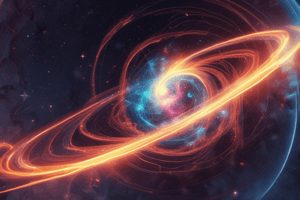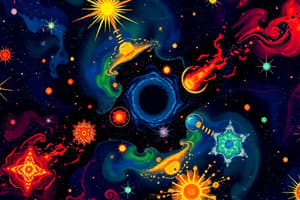Podcast
Questions and Answers
This theory states that all of the current and past matter in the Universe came into existence at the same time. Answer:
This theory states that all of the current and past matter in the Universe came into existence at the same time. Answer:
BIG BANG THEORY
It is a debunked model/theory that the Earth is the center of the universe, with the sun and planets revolving around it. Answer:
It is a debunked model/theory that the Earth is the center of the universe, with the sun and planets revolving around it. Answer:
GEOCENTRIC MODEL
A theory that planets were considered to have been formed as a result of a close approach to the Sun by some other stars. Answer:
A theory that planets were considered to have been formed as a result of a close approach to the Sun by some other stars. Answer:
CAPTURE THEORY
The Big Bang Theory is the leading explanation for how the universe began. Simply put, it says the universe as we know it started with an infinitely hot and dense single point that inflated and stretched — first at unimaginable speeds, and then at a more measurable rate — over the next 13.7 billion years to the still-expanding cosmos that we know today. The Big Bang Theory is the leading explanation for how the universe began. Simply put, it says the universe as we know it started with an infinitely hot and dense single point that inflated and stretched — first at unimaginable speeds, and then at a more measurable rate — over the next 13.7 billion years to the still-expanding cosmos that we know today. It is an explosive expansion ballooning our universe outwards faster than the speed of light. This was a period of cosmic inflation that lasted mere fractions of a second — about $10^{-32}$ of a second, according to physicist Alan Guth’s 1980 theory that changed the way we think about the Big Bang forever. It is an explosive expansion ballooning our universe outwards faster than the speed of light. This was a period of cosmic inflation that lasted mere fractions of a second — about ______ of a second, according to physicist Alan Guth’s 1980 theory that changed the way we think about the Big Bang forever.
The Big Bang Theory is the leading explanation for how the universe began. Simply put, it says the universe as we know it started with an infinitely hot and dense single point that inflated and stretched — first at unimaginable speeds, and then at a more measurable rate — over the next 13.7 billion years to the still-expanding cosmos that we know today. The Big Bang Theory is the leading explanation for how the universe began. Simply put, it says the universe as we know it started with an infinitely hot and dense single point that inflated and stretched — first at unimaginable speeds, and then at a more measurable rate — over the next 13.7 billion years to the still-expanding cosmos that we know today. It is an explosive expansion ballooning our universe outwards faster than the speed of light. This was a period of cosmic inflation that lasted mere fractions of a second — about $10^{-32}$ of a second, according to physicist Alan Guth’s 1980 theory that changed the way we think about the Big Bang forever. It is an explosive expansion ballooning our universe outwards faster than the speed of light. This was a period of cosmic inflation that lasted mere fractions of a second — about ______ of a second, according to physicist Alan Guth’s 1980 theory that changed the way we think about the Big Bang forever.
Before Big Bang, there was a plausible hypothesis which states that the physical world was made up of a soup of short-lived elementary particles, including quarks, the building blocks of protons and neutrons. There was both matter and 'antimatter' in roughly equal quantities. Before Big Bang, there was a plausible hypothesis which states that the physical world was made up of a soup of short-lived elementary particles, including quarks, the building blocks of protons and neutrons. There was both matter and 'antimatter' in roughly equal quantities. Before Big Bang, there was a plausible hypothesis which states that the physical world was made up of a soup of short-lived elementary particles, including ______, the building blocks of protons and neutrons. There was both matter and 'antimatter' in roughly equal quantities.
Before Big Bang, there was a plausible hypothesis which states that the physical world was made up of a soup of short-lived elementary particles, including quarks, the building blocks of protons and neutrons. There was both matter and 'antimatter' in roughly equal quantities. Before Big Bang, there was a plausible hypothesis which states that the physical world was made up of a soup of short-lived elementary particles, including quarks, the building blocks of protons and neutrons. There was both matter and 'antimatter' in roughly equal quantities. Before Big Bang, there was a plausible hypothesis which states that the physical world was made up of a soup of short-lived elementary particles, including ______, the building blocks of protons and neutrons. There was both matter and 'antimatter' in roughly equal quantities.
In the late 1940s, the astronomer George Gamow suggested that the initial explosion may have left some still observable traces. His reckoning was that a universe so hot and dense would have emitted a lot of light. With expansion, the characteristic temperature of this light would have. In the late 1940s, the astronomer George Gamow suggested that the initial explosion may have left some still observable traces. His reckoning was that a universe so hot and dense would have emitted a lot of light. With expansion, the characteristic temperature of this light would have. In the late 1940s, the astronomer George Gamow suggested that the initial explosion may have left some still observable traces. His reckoning was that a universe so hot and dense would have emitted a lot of light. With expansion, the characteristic temperature of this light would have ______.
In the late 1940s, the astronomer George Gamow suggested that the initial explosion may have left some still observable traces. His reckoning was that a universe so hot and dense would have emitted a lot of light. With expansion, the characteristic temperature of this light would have. In the late 1940s, the astronomer George Gamow suggested that the initial explosion may have left some still observable traces. His reckoning was that a universe so hot and dense would have emitted a lot of light. With expansion, the characteristic temperature of this light would have. In the late 1940s, the astronomer George Gamow suggested that the initial explosion may have left some still observable traces. His reckoning was that a universe so hot and dense would have emitted a lot of light. With expansion, the characteristic temperature of this light would have ______.
Flashcards are hidden until you start studying
Study Notes
The Big Bang Theory
- The theory states that all of the current and past matter in the Universe came into existence at the same time.
- The universe began as an infinitely hot and dense single point that inflated and stretched over the next 13.7 billion years.
- The inflation occurred at unimaginable speeds, and then at a more measurable rate, resulting in the still-expanding cosmos.
- The cosmic inflation lasted mere fractions of a second, about 10^-32 of a second, according to physicist Alan Guth’s 1980 theory.
Before the Big Bang
- A plausible hypothesis states that the physical world was made up of a soup of short-lived elementary particles, including quarks, the building blocks of protons and neutrons.
- There was both matter and 'antimatter' in roughly equal quantities before the Big Bang.
Evidence of the Big Bang
- The astronomer George Gamow suggested that the initial explosion may have left some still observable traces.
- The universe's initial heat and density would have emitted a lot of light, which would have decreased in temperature with expansion.
- The characteristic temperature of this light would have changed over time.
Studying That Suits You
Use AI to generate personalized quizzes and flashcards to suit your learning preferences.




